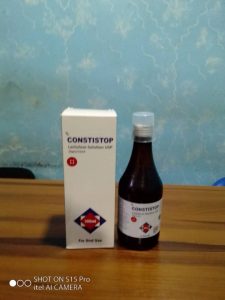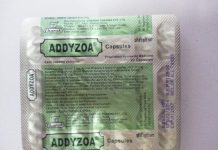Lactulose Solution for constipation:Uses, ingredients , Indications, Dosage, Contraindications, Interactions, Side Effects.
Lactulose solution USP
Each 15ml contains:
Lactulose concentrate USP
eq. to Lactulose 10gm
Colour : caramel
Aqueous flavoured base

CLINICAL pharmacology :
Mechanism of action of lactulose:
Lactulose is poorly absorbed from the gastrointestinal tract, and no enzyme capable of hydrolysis of this disaccharide is present in human gastrointestinal tissue. As a result, oral doses of lactulose solution reach the colon virtually unchanged . In the colon, lactulose is broken down primarily to lactic acid, and also to small amounts of formic and acetic acids, by the action of colonic bacteria which results in an increase in osmotic pressure and slight acidification of the colonic contents. This in turn causes an increase in stool water content and softens the stool.
Since lactulose does not exert it’s effect until it reaches the colon, and since transit time through the colon may be slow, 24 to 48 may be required to produce the desired bowel movement.
Urinary excretion has been determined to be 3% or less and is essentially complete within 24 hours.
INDICATIONS AND USAGE OF LACTULOSE :
For the treatment of constipation. In patients with a history of chronic constipation, lactulose solution therapy increases the number of bowel movements per day and the number of days on which bowel movements occur.
This drug is used by mouth or rectally to treat or prevent complications of liver disease ( hepatic encephalopathy). It does not cure the problem, but may help to improve mental status. Lactulose is a colonic acidifier that works by decreasing the amount of ammonia in the blood.
CONTRA-INDICATIONS OF LACTULOSE:
Since lactulose solution contains galactose (less than 1.6 gm/15 ml), it is contraindicated in patients who require a low galactose diet.
INTERACTIONS:
Results of preliminary studies in humans and rats suggest that nonabsorbable antacids given concurrently with lactulose may inhibit the desired lactulose – induced drop in colonic pH. Therefore, a possible lack of desired effect of treatment should be taken into consideration before such drugs are given concomitantly with lactulose solution.
READ ALSO: Over the counter laxatives in Nigeria
WARNINGS AND PRECAUTION :
A theoretical hazard may exist for patients being treated with lactulose solution who may required to undergo electrocautery procedures during proctoscopy or colonoscopy. Accumulation of H2 gas in significant concentration in the presence of an electrical spark may result in an explosive reaction. Although this complication has not been reported with lactulose, patients on lactulose therapy undergoing such procedures should have a thorough bowel cleansing with a non- fermentable solution. Insufflation of CO2 as an additional safeguard may be pursued but is considered to be a redundant measure.
ADVERSE REACTIONS AND SIDE EFFECTS OF LACTULOSE:
Initial doses may produce flatulence and intestinal cramps, which are usually transient. Excessive dosage can lead to diarrhoea with potential complications such as loss of fluids, hypokalemia, and hypernatremia. Nausea and vomiting have been reported.
Gas, bloating , burping, stomach rumbling /pain, nausea and cramps may occur.
Tell doctor immediately if any of these unlikely, but seek immediate medical attention if it occurs.
Symptoms of a serious allergic reaction may include : rash, itching /swelling ( especially of the face /tongue / throat), severe dizziness, trouble breathing.
PREGNANCY
Lactulose solution is safe in pregnancy. Low dose may be given to constipated pregnant women.
SYMPTOMS OF OVERDOSE AND ANTIDOTE :
There have been no reports of accidental overdosage. In the event of overdosage, it is expected that diarrhea and abdominal cramps would be the major symptoms. Medication should be terminated.
DOSAGE AND ADMINISTRATION :
Children :
Oral: individualize dose to produce 2-3 soft stools daily. Infants: initially 2.5 -10ml in divided doses. Older children and adolescents : 40-90ml/daily. If initial dose causes diarrhea, reduce dose immediately ; discontinue if diarrhea persists.
Adult :
Oral: 30- 45ml 3-4 times daily ; May adjust dose every day or two to produce 2-3 soft tools daily. Hourly reduce dose of 30-45 ml may be used to induce rapid laxation initially ; when laxative effect has been achieved, reduce dose to recommended daily dose.
Maintenance : continue recommended daily dose.
Rectal: may be given as a retention enema via a rectal balloon catheter. Mix 300 ml of lactulose solution with 700 ml of water or physologic saline, retain for 30-60 minutes. May repeat every 4-6 hours; if evacuated too promptly, may be repeated immediately. Start oral route before stopping enema entirely.
PRESENTATION :
300ml bottle pack in one carton.
STORAGE :
Preserve in tight container, preferably at a temperature below 30°C.
WARNING:
Keep this medicine out of the reach of children.
























